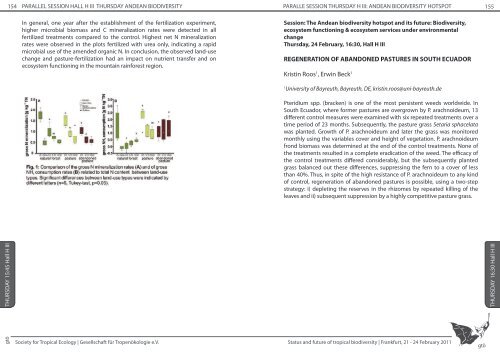152 PARALLEL SESSION HALL H III THURSDAY ANDEAN BIODIVERSITYPARALLE SESSION THURSDAY H III: ANDEAN BIODIVERSITY HOTSPOT153Session: The Andean biodiversity hotspot and its future: Biodiversity,eco system functioning & ecosystem services under environmentalchangeThursday, 24 February, 15:30, Hall H IIIINFLUENCE OF SHALLOW LANDSLIDES ON FOREST DYNAMICS IN ASOUTH ECUADORIAN TROPICAL MONTANE FORESTClaudia Dislich 1 , Andreas Huth 11UFZ Leipzig, Leipzig, DE, claudia.dislich@ufz.deThe Andean biodiversity hotspot and its future: Biodiversity, eco systemfunctioning & ecosystem services under environmental changeThursday, 24 February, 15:45, Hall H IIIIMPLICATIONS OF LAND-USE CHANGE AND PASTURE-FERTILIZATION ON SOIL MICROBIAL ACTIVITIES ANDCOMMUNITIES IN A MOUNTAIN RAINFOREST REGION OFSOUTHERN ECUADORKarin Potthast 1 , Ute Hamer 1 , Franz Makeschin 1THURSDAY 15:30 Hall H IIIShallow landslides are a major source of natural disturbance in tropical montane<strong>for</strong>ests. Due to shallow landslides vegetation and often the upper soil areremoved, leaving space <strong>for</strong> a quasi primary succession and resulting in stronglychanged conditions <strong>for</strong> <strong>for</strong>est regeneration. Landslides might there<strong>for</strong>e affectdifferent processes of <strong>for</strong>est dynamics: tree growth can be reduced due tonutrient limitation, tree recruitment can be reduced due to a thick vegetationof shrubs and ferns that establishes on young landslide sites and mortality canbe increased due to instability of soils and exposition to wind. We utilize anindividual based model of <strong>for</strong>est growth to investigate how changes in theseprocesses affect the temporal and spatial succession process and to estimatethe effect of landslides on the carbon balance of <strong>for</strong>est. The <strong>for</strong>est model wasparameterized <strong>for</strong> one <strong>for</strong>est type of the Reserva Biológica San Francisco inthe Andes of South Ecuador, where approximately 4% of the area is coveredwith visible traces of landslides. The terrain is characterized by deeply incisedvalleys and steep slopes. We developed different scenarios of <strong>for</strong>est successionafter landslides, where different processes (tree growth, recruitment, mortality)are changed compared to processes in undisturbed <strong>for</strong>est. For the differentscenarios we find distinct patterns of spatial variation of tree biomass within thefirst fifty years of succession. For all scenarios, overall tree biomass recovers afterapproximately 100 years but species composition takes longer time to recover(> 200 years). On the landscape level landslides reduce standing biomass andproduce a high spatial heterogeneity.1TU Dresden/Soil Science, Dresden, DE, kpotthast@web.deIn the South Ecuadorian Andes, vast areas of the mountain rain<strong>for</strong>est havebeen converted to cattle-pastures by slash and burn practice. Frequently, thesepastures were invaded by the fire-tolerant tropical bracken fern. When thebracken becomes dominant on the pasture sites the productivity decreasesand the sites are abandoned. To assess the implications of land-use changesand pasture-fertilization on ecosystem functioning, a study was conductedin the area of the German research station Estación Científica San Francisco(ECSF) in Ecuador. For comparison of different land-uses three adjacent siteswere selected at 2000 m asl: a mountain rain<strong>for</strong>est site, an active pasture sitedominated by the grass species Setaria sphacelata and an abandoned pasturesite overgrown by bracken (Pteridium arachnoideum). To investigate theeffect of the fertilization of pastures with urea and/or rock phosphate on soilmicrobial properties, a fertilization experiment was conducted in situ as well.For soil microbial analysis, the amounts of microbial biomass (CFE-method), themicrobial activity (basal respiration; net and gross N mineralization rates) andthe microbial community structure (PLFA-analysis) were determined.17 years after pasture establishment, a threefold higher content of microbialbiomass C and N as well as significantly lower C:N ratios were determinedcompared to the other land-uses. Furthermore, highest C and gross Nmineralization rates (Fig.1) were observed in the pasture soil. An activelymicrobial inorganic N immobilization indicated an easy availability of organicsubstrates partly due to the prolific fine-root system of the pasture grass. Thesedifferences within the land-use gradient were also associated with shifts in themicrobial community structure (MCS). After bracken-invasion the MCS shiftedagain towards the <strong>for</strong>est whereby a higher relative abundance of actinomyceteswas associated with a higher acidity and exchangeable Al-concentration.THURSDAY 15:45 Hall H IIIgtö<strong>Society</strong> <strong>for</strong> <strong>Tropical</strong> <strong>Ecology</strong> | Gesellschaft für Tropenökologie e.V. Status and future of tropical biodiversity | Frankfurt, 21 - 24 February 2011gtö
154 PARALLEL SESSION HALL H III THURSDAY ANDEAN BIODIVERSITYPARALLE SESSION THURSDAY H III: ANDEAN BIODIVERSITY HOTSPOT155In general, one year after the establishment of the fertilization experiment,higher microbial biomass and C mineralization rates were detected in allfertilized treatments compared to the control. Highest net N mineralizationrates were observed in the plots fertilized with urea only, indicating a rapidmicrobial use of the amended organic N. In conclusion, the observed land-usechange and pasture-fertilization had an impact on nutrient transfer and onecosystem functioning in the mountain rain<strong>for</strong>est region.Session: The Andean biodiversity hotspot and its future: Biodiversity,eco system functioning & ecosystem services under environmentalchangeThursday, 24 February, 16:30, Hall H IIIREGENERATION OF ABANDONED PASTURES IN SOUTH ECUADORKristin Roos 1 , Erwin Beck 11University of Bayreuth, Bayreuth, DE, kristin.roos@uni-bayreuth.dePteridium spp. (bracken) is one of the most persistent weeds worldwide. InSouth Ecuador, where <strong>for</strong>mer pastures are overgrown by P. arachnoideum, 13different control measures were examined with six repeated treatments over atime period of 23 months. Subsequently, the pasture grass Setaria sphacelatawas planted. Growth of P. arachnoideum and later the grass was monitoredmonthly using the variables cover and height of vegetation. P. arachnoideumfrond biomass was determined at the end of the control treatments. None ofthe treatments resulted in a complete eradication of the weed. The efficacy ofthe control treatments differed considerably, but the subsequently plantedgrass balanced out these differences, suppressing the fern to a cover of lessthan 40%. Thus, in spite of the high resistance of P. arachnoideum to any kindof control, regeneration of abandoned pastures is possible, using a two-stepstrategy: i) depleting the reserves in the rhizomes by repeated killing of theleaves and ii) subsequent suppression by a highly competitive pasture grass.gtöTHURSDAY 15:45 Hall H IIITHURSDAY 16:30 Hall H III<strong>Society</strong> <strong>for</strong> <strong>Tropical</strong> <strong>Ecology</strong> | Gesellschaft für Tropenökologie e.V. Status and future of tropical biodiversity | Frankfurt, 21 - 24 February 2011gtö












